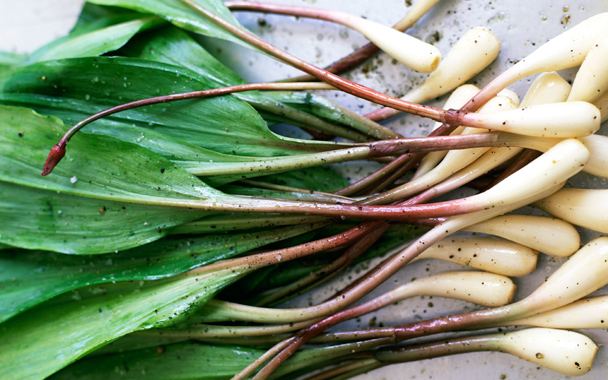In the dog days of winter, when my breath freezes as I exhale and the idea of spring seems like a cruel joke, there is something I begin to think about, then fixate on: a light at the end of an icy tunnel. Some cooks I know dream of tender asparagus; others fantasize about the sweetness of peas. I begin to dream of ramps. To me nothing announces the end of winter like the arrival of ramps. By this time of year I’ve spent too many mornings walking to the train with my hands shoved deep in my pockets to stay warm, gloves long since lost, root-vegetable crazy, pale and muttering to myself: Yes my precious, soon my precious, ramps will be here.
Ramps (Allium trioccum) are a member of the lily family, which includes garlic, leeks, and onions. Built a little like scallions, ramps have elegant green leaves growing from a richly purple stalk that fades to a white bulb. Below the bulb, roots hang down like dendrites. Ramps are often called wild leeks or wild garlic, and if you taste them you will know why: They occupy a middle ground of flavor, with the sweetness of leeks and the bite of garlic. And this flavor is delicious.
Ramps grow wild all over the United States and seem to come and go as they please. For years a patch may be plentiful and then, suddenly, it will yield nothing at all. When they are growing abundantly, ramps will often invade otherwise cultivatable land. One farmer I know, who used to sell us ramps by the garbage bag, claimed to have been desperate to kill the weed that suddenly appeared, took over a fifth of his usable land, and radically shrunk the yield of his salable crops. He tried everything he could think of that wouldn’t poison the soil, but the ramps would not die. I think his despair lifted when crackpots calling themselves chefs began showing up at his farm and offering to buy the weed at outrageous prices not unlike those of, well, weed.
I have not put ramps in my pipe, but I have smoked them—and also roasted, sautéed, blanched, pickled, braised, and puréed them. I have eaten them raw and dirty, and I have cleaned so many in a row that I almost wished for winter again. This year I may take a few home to put under my pillow, just because…my precious. I’ll buy a little grill and set it up on my fire escape, coating the ramps in olive oil, salt, and pepper and grilling them until the white flesh is soft and smoky but still toothsome, the leaves limp and folded in on themselves, tender, wet, and charred at the edges. Then I will eat them—right from the grill, with a little fresh bread if I can wait, but probably just by the handful, with nothing else.
At Babbo, one way we prepare ramps is by heating a sauté pan until the olive oil is just beginning to smoke. We pull the pan off the flame and toss in the ramps, shorn of their leaves. We hear the sizzle, see the spattering oil, and toss them once or twice, calming the pan before placing it back on the flame. We sear them until the whites are blistered, brown, and soft. We add garlic to the pan to amplify that flavor, toasting it to make it taste nutty. After 6 minutes and 30 seconds in boiling water, we add 4 oz of linguine—supple but still al dente—to the pan. We throw in breadcrumbs for texture and add the julienned raw ramp leaves, which wilt in the steam of the pasta and bring a brightness of color and flavor to the dish. We toss everything a few times before plating and then grate Pecorino Romano over the top, so that it melts slightly by the time the dish makes its way onto the table. It may be my favorite pasta ever.
Ramps will soon appear in farmers markets in many parts of the country. If you find some, and they are fresh and vibrant, bring a handful home. Coat them lightly but thoroughly in olive oil, liberally in salt and pepper. Sear them in a hot pan, or grill them over wood or coals. Add a little lemon juice—just a little—and celebrate the end of winter.
- Try some of Gourmet’s ramp recipes:
- Ramp Grits Soufflé
- Ramp Soup
- Ramp Tart
- Roasted Chicken, Ramps, and Potatoes
- Spaghetti with Ramps




 Pinterest
Pinterest


